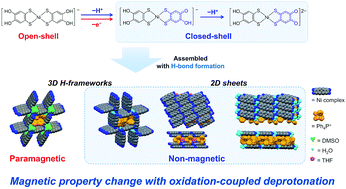Modulation of the electronic states and magnetic properties of nickel catecholdithiolene complex by oxidation-coupled deprotonation†
Abstract
Electronic-state modulation utilizing the electrostatic properties and dynamics of hydrogen-bonding (H-bonding) protons is an effective strategy for realizing novel electron–proton-coupled functionalities. However, material developments based on this strategy have been limited to a few π-electron systems; thus, the realization of solid-state electron–proton-coupled functionalities is challenging. Here, we successfully synthesized new crystals based on nickel catecholdithiolene complexes, which are d/π-electron systems with H-bonds, exhibiting various deprotonation/oxidation states brought about via solution processes. In these crystals, unique three-dimensional framework or two-dimensional sheet structures are formed by intermolecular H-bonds between the complexes, including anionic [O–H⋯O]− H-bonds (dO⋯O ∼ 2.59 Å), which were advantageous for proton transfer in solid states. Importantly, detailed analyses revealed that the nickel complexes in the crystals were in various oxidation/deprotonation states. Accordingly, the magnetic properties changed from paramagnetic to non-magnetic with the oxidation of the complexes through proton-coupled electron transfer in solution processes. Density functional theory calculations revealed that the d/π electronic states of the nickel complexes in each crystal are significantly modulated depending on the deprotonation/oxidation states. We propose a possible mechanism for the oxidation-coupled deprotonation of the nickel complex, where various oxidation/deprotonation states can be obtained as crystals and controlled by recrystallization conditions, which is realized by the characteristic d/π-conjugation property and (de)protonation/redox activity of the nickel catecholdithiolene complex. The findings provide a further possibility to construct d/π-electron–proton-coupled collective functionalities based on this complex, together with significant insights for exploring novel electron–proton-coupled functionalities in the solid state.

- This article is part of the themed collection: Materials for molecular electronics and magnetism


 Please wait while we load your content...
Please wait while we load your content...